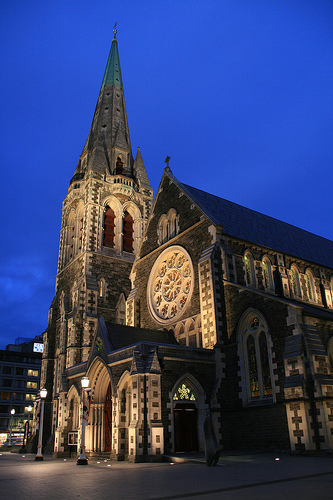
[For more information see New Zealand: Law and Religion Framework Overview (2018)]
In New Zealand, just over half of the population at the 2006 New Zealand Census declared an allegiance to Christianity. However, regular church attendance is probably closer to 15%. Before European colonisation the religion of the indigenous Māori population was animistic, but the subsequent efforts of missionaries such as Samuel Marsden resulted in most Māori converting to Christianity.
New Zealand has no state religion and freedom of religion has been protected since the signing of the Treaty of Waitangi.
More recently the number of adherents of non-Christian religions has increased dramatically due to immigration and dispersal of culture, to around 5% in 2006. Roughly one-third of New Zealanders claim no religious affiliation.
New Zealand’s religious history after the arrival of the Europeans was characterised by substantial missionary activities (with Māori conversions to Christian faith generally being voluntarily, unlike some missionary work in previous centuries in other parts of the world) as well as by the new immigrants bringing their particular Christian faiths with them.
The religious climate of early New Zealand was influenced by ‘voluntarism’. Whereas in Britain, the Anglican Church was an established state church, by the middle of the 19th century even the Anglicans themselves sometimes doubted this arrangement, while the other major denominations of the new colony (Presbyterians, Methodist and Catholics) obviously preferred that the local set up allowed for all their groups.
Initial religious distribution was heavily influenced by the fact that local communities were still small and often came from comparatively small regions in the origin countries in Great Britain. As a result, by the time of the 1921 census, no uniform distribution existed amongst the Non-Māori Christian, with Presbyterians being the dominant group in Otago and Southland, Anglicans in the Far North, the East Cape and various other areas including the Banks Peninsula, while Methodists flourished mainly in the Taranaki and Manawatu. Catholicism meanwhile was the dominant religion on the West Coast with its many mining concerns, and in Central Otago. The Catholic Church, while not being particularly dominant in terms of pure numbers, became especially known throughout the country in the early and middle 20th century for its strong stance on education, establishing large numbers of schools.
Religious affiliation has been collected in the New Zealand Census of Population and Dwellings since 1851. Statistics New Zealand state that:
Religious affiliation is a variable of strong interest to religious organisations, social scientists, and can be used as an explanatory variable in studies on topics such as marriage formation and dissolution, fertility and income.
One of the many complications in interpreting religious affiliation data in New Zealand is the large proportion who object to answering the question, roughly 240,000 in 2006. Most reporting of percentages is based on the total number of responses, rather than the total population.
In the early 20th century New Zealand census data indicates that the vast majority of New Zealanders affiliated with Christianity. The total percentages in the 1921 non-Māori census were 45% Anglicans, 19.9% Presbyterians, 13.6% Catholics, 9.5% Methodists and 11.2% Others. Statistics for Māori were only available from 1936, with 35.8% Anglicans, 19.9% Ratana, 13.9% Catholics, 7.2% Ringatu, 7.1% Methodists, 6.5% Latter Day Saints, 1.3% Methodists and 8.3% Others recorded at this census.
The population increased 7.8% between the 2006 and 2001 census. The most notable trend in religion over that time is the 26.2% increase in the number of people indicating no religion.
Mirroring the recent immigration trends to New Zealand, immigrant religions increased fastest between the census, Sikh by 83% to 9,507, Hindu by 61.9% to 64,392, Islam by 53% to 36,072 and Buddhist by 25.8% to 52,392. Others that increased faster than the general population include Pentecostal Christianity (Assemblies of God, Elim), Baptist, Evangelical Christianity, Latter-day Saints and New Age.
Mainstream Christian denominations, while still representing the largest categories of census religious affiliation, are not keeping pace with population increase. Anglicans fell by 29,868 to 554,925 and Presbyterians decreased by 30,102 to 401,445. While Roman Catholic numbers increased by 22,797 to 508,437 (4.7%), this was less than the total population increase. The only other religious group above 100,000 members is Methodist. Compare this with numbers in 1901, where 42% of people identified with the Anglican denomination, 23% with Presbyterian, and only 14% with Catholic[citation needed]. At this time 1 in 30 people did not identify with any religion compared with 1 in 3 today. If the current trends continue, Christianity will no longer be the majority religion at the 2011 census.
The International Social Survey Programme was conducted in New Zealand by Massey University in 2008. It received mail-responses from around one thousand New Zealanders above the age of 18, surveying issues of religious belief and practice. The results of this survey indicated that 72% of the population believe in God or a higher power, 15% are agnostic, and 13% are atheist (with a 3% margin of error).
Encouraged by an informal email campaign, over 53,000 people listed themselves as Jedi in New Zealand’s 2001 census (over 1.5% of responses). If the Jedi response had been accepted as valid it would have been the second largest religion in New Zealand. However, Statistics New Zealand treated Jedi responses as “Answer understood, but will not be counted”.[9] The city of Dunedin (a university town) had the highest population of reported Jedi per capita[citation needed]. In the 2006 census only 20,000 people gave Jedi as their religion.